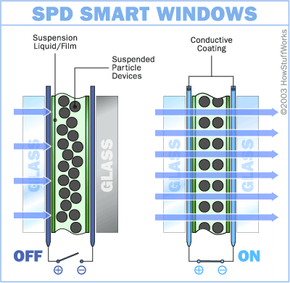Suspended Particle Devices
Windows serve an important function in homes and commercial buildings. They not only let light in to cut down on electricity use for lighting, but the light coming through the window also provides heat. However, windows are not something people typically associate with being a cutting-edge technology. One tenacious company is trying to change that by offering a patented technology that enables a window to quickly change from clear to opaque and anywhere in between with the flip of a switch.
Conventionally, curtains and mini-blinds have been used to block out light and give us privacy, but they don't block out all of the light. Research Frontiers has developed a type of window that uses small light-absorbing microscopic particles known as suspended particle devices (SPD), or light valves to make it go from clear to dark in a matter of seconds. Here's a breakdown of the parts that make up SPD light-control windows:
Advertisement
- Two panels of glass or plastic
- Conductive material - used to coat the panes of glass
- Suspended particle devices - millions of these black particles are placed between the two panes of glass
- Liquid suspension or film - allows the particles to float freely between the glass
- Control device - automatic or manual
How the SPD windows work is very simple, if you think of SPDs as light valves. In an SPD window, millions of these SPDs are placed between two panels of glass or plastic, which is coated with a transparent conductive material. When electricity comes into contact with the SPDs via the conductive coating, they line up in a straight line and allow light to flow through. Once the electricity is taken away, they move back into a random pattern and block light. When the amount of voltage is decreased, the window darkens until it's completely dark after all electricity is taken away.
Users apply a moderate amount of voltage to the conductive material on the window panes through a control device. Several control methods are offered with the SPD light-control windows, including remote and automatic devices. The windows can be controlled manually with a rheostat or remote. Or, photocells and other sensing devices could be used to control the level of light automatically.
Research Frontiers holds about 470 worldwide patents on this light-control technology and has several licensees, including corporate giants like Polaroid and GE. Suspended particle devices can be used for a multitude of other consumer products, including sunroofs, sun visors, rearview mirrors, ski goggles and flat-panel displays for computers.
Now, you may be thinking, "Well, this sounds great, but I don't want to have to replace all the windows in my home." You might not have to. Research Frontiers has a patent -- No. 6,429,961 entitled, "Methods for Retrofitting Windows with Switchable and Non-Switchable Window Enhancements" -- that will enable homeowners to upfit their existing windows with SPD technology. And, if you're wondering "How energy efficient can it be to have windows that you essentially have to turn on for a clear view outside?" Reportedly, you can power about 15 large SPD smart windows in your home for less electricity than it takes to operate a simple night-light.
SPD technology isn't the only smart-window technology on the block. Liquid crystals have been in use for years, and electrochromics essentially performs the same functions as suspended particles. In the next sections, we will look at these two technologies.
